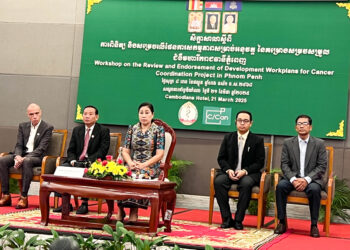Workshop to launch and disseminate of the (NATSC) 2021 country report on 21 February 2023 chaired by Secretary of State of the Ministry of Health and the permanent vice chairperson of the Inter-Ministerial Committee (IMC) for Tobacco Control, Secretary of State of the Ministry of Tourism, Under-Secretary of State of the Ministry of Economy and Finance and the chairperson of the Working Group on Tobacco Taxation, Under-Secretary of State of the Ministry of Interior and WHO to present the key findings and recommendations including the tobacco tax and the remarkable progress in tobacco control in Cambodia as the result of the implementation of the WHO FCTC for 22 government ministries, municipality and provincial who are members of Inter-Ministerial Committee for Tobacco Control (IMC) and provincial health departments, municipality, relevant institutions, and partner organizations.
Summary of the Key Findings of
Tobacco Use
The findings showed that cigarette smoking was the main form of tobacco use in Cambodia. There were 2,172,585 current tobacco users, of which 1,631,366 were current smokers. Considering prevalence, 28.62% of males and 8.88% of females used any form of tobacco products. More than one quarter (25.35%) of males and 2.05% of females were current smokers. About 10% (10.73%) of respondents in urban and 14.34% of respondents in rural areas smoked cigarettes. A small percentage (0.27%) of males and 6.53% of females chewed tobacco products.
Cessation and Quitting Attempt
The practice of health providers on assessing tobacco use and providing advisement to quit tobacco use among their patients was very low. A very small percentage (9.64%) of male and 8.10% of females reported that they were asked about chewing tobacco. Similarly, more than one in every three males and 10.45% of females were asked about their smoking. Nearly half of male tobacco smokers and 12.90% of female tobacco smokers were advised to stop smoking tobacco in the past 12 months.
A very small proportion of respondents in urban areas (6.58%), and in rural areas (10.20%) were asked about chewing tobacco products, when they visited health providers.
Thinking about quit smoking
More than one third of males, and 37.79% of females planned to quit someday but not within the next 12 months. A very small percentage of males (1.31%), and 0.95% of females planned to quit smoking tobacco within the next month.
Second-hand Smoke
More than one in every four respondents (27.36%), a total of 1,721,848 Cambodian adult aged 15 and older, were exposed to second-hand smoke at home during the past 30 days. Nearly 30% of males and more than one-quarter of females are exposed to second-hand smoke at home.
Overall, 15.84% of respondents, totalling 1,981,418 Cambodia adult age 15 and older, are exposed to secondhand smoke inside a public area. This includes 14.13%, or and estimated 1,767,421 Cambodia adult age 15 and older, who were specifically exposed to second-hand smoke inside a building.
Economics
On average, tobacco users annually spent USD 235,062,723 to purchase tobacco products. The tobacco users in rural area were likely to spend more money to buy tobacco products than the tobacco users in urban areas.
Media-Exposure to Anti and Pro-Tobacco Messages
The majority (61.76%) of males and 62.35% of females were exposed to pictorial health warnings, while nearly 40% of males and 37.65% of females noted text-based health warnings in Khmer on a cigarette package.
With respect to residence, 40.72% of respondents in urban areas, and about three quarters of the respondents in rural areas saw a pictorial health warning. Whereas a majority (59.25%) of respondents in urban areas and more than one quarter of the respondents in rural area noticed text-based health warnings in Khmer.
The majority (84.10%) of males and females (82.55%) supported the larger pictorial health warning on a cigarette pack.
Exposure to pro-tobacco messages
Overall, 26.6% of respondents were exposed to any forms of TAPS followed by advertising of tobacco products (26.40%).
Attitudes toward Tobacco Tax and Price
With respect to attitudes, 95%, of respondents supported an increase in cigarette tax, and 95.75% supported an increase in the price of tobacco products.
Approximately 97.49% of respondents in urban areas, and 94.75% of respondents in rural areas supported increased cigarette tax.
Interestingly, the majority of the tobacco smokers supported increased cigarette tax (82.84%) /or price (82.64%).
Media Channel Consumptions
Notably, 7,745,200 Cambodian people age 15 and older were exposed to Facebook, You Tube, Telegram, Twitter, and WhatsApp combined. While 6,449,890 of Cambodian people aged 15 and older were exposed to mass media (both TV and radio) in the past 30 days
Conclusions
Relative to the NATSC 2014, NATSC 2021 showed trends towards lower prevalence of tobacco use, cigarette smoking, exposure to second-hand smoke inside workplace, government offices, health care facilities, and restaurants, Tobacco Advertising, Promotion, and Sponsorship of tobacco products. The absolute number of tobacco users and cigarettes smokers remained statistically unchanged; however, the money spent on tobacco has more than doubled over the past 16 years. Moreover, important violations of smoke free workplaces and public places were found, only 55% of packs depicted a pictorial health warning, and tobacco advertising, promotion, and sponsorship remained evident. There were no health provider norms in assessing the tobacco use behaviours of their patients, and at the same time, tobacco users were not interested in quitting tobacco.
Recommendations
- It is essential to improve the practice of the health providers at all levels, in particular at health center level, to create a practice of asking about the tobacco use of their patients. At the same time, national public health programs need to stimulate smoking cessation demands in the community, while concomitantly creating smoking cessation programs.
- More work is needed to enforce tobacco control legislation. In particular, the 55% pictorial health warning on pack, smoke free workplaces and public places, and tobacco advertising promotion, and sponsorship bans. In the future, this should also include enlarging of the current pictorial health warnings on tobacco packaging.








